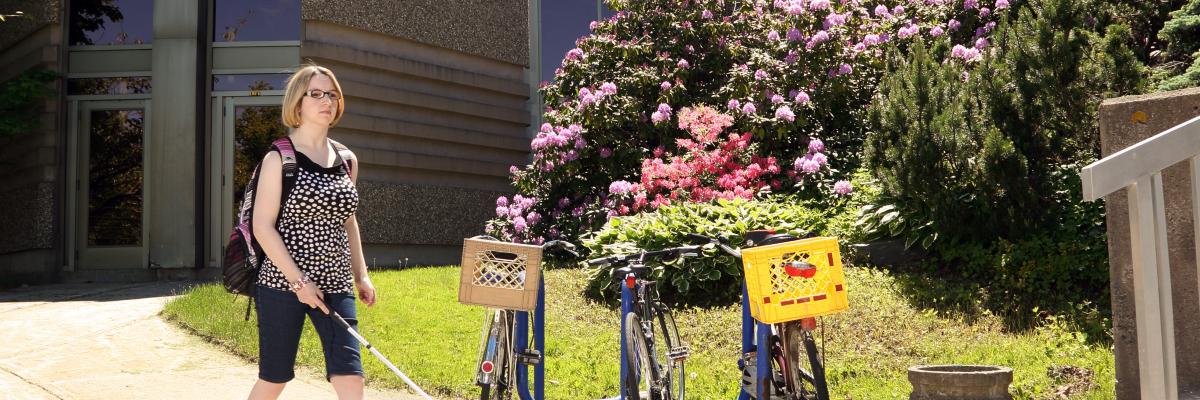When you’re blind or partially sighted, navigating your surroundings takes special skills and tools.
Orientation and mobility
Orientation and mobility training (O&M) teaches the set of skills that someone who is blind or partially sighted uses to navigate their environment safely and independently, which includes someone learning how to use their remaining senses to stay oriented in your environment. O&M specialists assess their clients’ needs and identify goals for independence, achieved by using tools like a white cane or a guide dog, and using a person’s remaining senses to interpret the environment. O&M goals can range from simple indoor travel to complex travel in the community involving street crossings and mass transit use. Vision Loss Rehabilitation Canada (VLRC) is a not-for-profit national healthcare organization and the leading provider of rehabilitation therapy and healthcare services for individuals with vision loss. Visit Vision Loss Rehabilitation Canada to learn more about their Orientation and mobility services.
Crossing the road safely
Some intersections have Accessible Pedestrian Signal (APS), which a pedestrian can activate to get distinct tones, melodies or customized messages indicating what the crossing light is displaying. APS buttons can also vibrate to make them accessible to those who are unable to hear the signal. O&M training will teach a blind or partially sighted pedestrian to watch or listen to traffic patterns and identify what type of traffic controls are present and how to use the traffic movement to safely cross the street (typically by using the closest parallel traffic surge).
Environmental cues
There are other auditory and tactile cues that someone with sight loss can use to navigate safely. For example, different ground types feel distinct when walking or sweeping a white cane over them, such as soft grass vs the hard concrete of the sidewalk. The sound of voices or music can help someone locate a doorway, as can a change in temperature (such as a draft of cool air in summer, or warm air in winter from an open door).
Landmarks
People who are blind or partially sighted often navigate by landmarks. Someone may not be able to read the sign for "Baker St." but will know it as the street with the tall hedge on the corner. They may not be able to read the house number but know that they want to turn in at the fourth driveway after the house with the wooden planter boxes.
The white cane
The white cane is one of the most common tools used by people who are blind to safely navigate their surroundings. Recognized around the world, it’s also an important identification tool. It’s a clear signal to others the user is a person with sight loss.
There are three types of canes:
- Identification canes are lightweight and are typically used to help with depth perception and finding things like stairs or curbs.
- Support canes are designed to support a person’s weight, providing stability.
- Long canes are used as probes to sweep and scan the environment, detect objects in a person’s path, changes in the walking surface and potential hazards like steps and curbs.
CNIB is advocating to build awareness with Canadians about the white cane and how it is used, what it signifies, and how to effectively assist when requested by someone who is blind or partially sighted. Visit our White Cane Awareness webpage to learn more.
Guide dogs
Guide dogs are bred and trained to guide people who are blind around their environment by avoiding obstacles, indicating hazards and locating destinations. Working as a team, these incredible animals give their handlers independence and confidence. Learn more about guide dogs.
GPS and navigation apps
Many people with sight loss use global positioning system (GPS) tools and navigation apps like BlindSquare and Aira, often in combination with a cane or guide dog. These solutions are helpful for getting information about their surroundings. Check out the Technology section of our site to learn more about these high-tech tools.
Sighted guide
There are times when people who are blind find guidance from a sighted person helpful. It’s a great way to safely and respectfully guide someone who’s blind. Learn more about the sighted guide technique.
